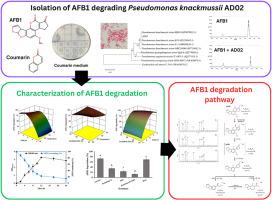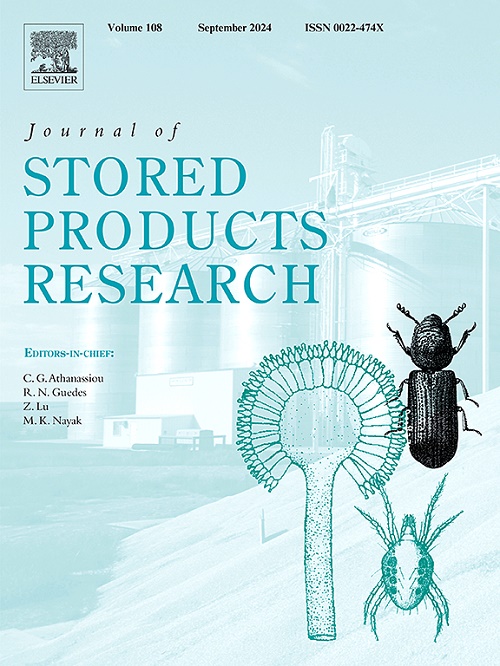探索利用假单胞菌(Pseudomonas knackmussii AD02)对收获后黄曲霉毒素污染进行生物缓解:特征和降解机制
IF 2.7
2区 农林科学
Q1 ENTOMOLOGY
引用次数: 0
摘要
黄曲霉毒素具有强烈的致癌和致突变特性,对人类和动物健康构成重大威胁。由于气候变化的影响,黄曲霉毒素污染已成为一个重要的食品安全问题,因此有必要开发有效的解毒策略,以减轻其对健康的严重危害。本研究从花生种植土壤中分离、鉴定和鉴定了能够降解黄曲霉毒素 B1(AFB1)的细菌菌株。分离过程中使用了香豆素作为选择性碳源。细菌分离物 AD02 的 AFB1 降解效率最高(88.85%)。形态学和基因分析证实,AD02 是一种革兰氏阴性棒状杆菌,与 knackmussii 假单胞菌关系密切。采用 Box-Behnken 设计进行的优化研究表明,初始 pH 值对 AFB1 降解有显著影响,最佳条件是 pH 值为 7、温度为 25 °C、培养 24 小时,AFB1 降解率约为 90%。此外,P. knackmussii AD02 还能同时降解 AFB1、AFB2、AFG1 和 AFG2 的混合物。对 AFB1 降解机理的研究揭示了细胞外酶的作用,特别是在蛋白质和膜相关成分中。AFB1 的降解机制涉及香豆素分子中内酯环的水解裂解,然后是环戊烯酮环的裂解以及呋喃和香豆素分子中双键的消除。硅学预测结果表明,这种细菌可以将 AFB1 代谢为非致畸和非致癌的中间产物。这项研究是有关 P. knackmussii 降解黄曲霉毒素的首次报道,凸显了它作为一种有效的黄曲霉毒素解毒生物制剂的潜力。本文章由计算机程序翻译,如有差异,请以英文原文为准。

Exploration of Pseudomonas knackmussii AD02 for the biological mitigation of post-harvest aflatoxin contamination: Characterization and degradation mechanism
Aflatoxins, known for their potent carcinogenic and mutagenic properties, pose a major threat to human and animal health. Due to the impacts of climate change, aflatoxin contamination has emerged as a critical food safety issue, necessitating the development of effective detoxification strategies to mitigate its severe health risks. The current isolated, identified, and characterized bacterial strains from peanut-growing soils that are capable of degrading aflatoxin B1 (AFB1). Coumarin was used as a selective carbon source during isolation. Bacterial isolate AD02 had the highest AFB1 degradation efficiency (88.85%). Morphological and genetic analyses confirmed AD02 as a Gram-negative, rod-shaped bacterium closely related to Pseudomonas knackmussii. Optimization studies using a Box-Behnken design showed that initial pH significantly affected AFB1 degradation, with the optimal conditions identified as pH 7, 25 °C, and 24 h of incubation, resulting in approximately 90% AFB1 degradation. Additionally, P. knackmussii AD02 simultaneously degraded a mixture of AFB1, AFB2, AFG1, and AFG2. A mechanistic study of AFB1 degradation revealed the role of extracellular enzymes, particularly in proteinaceous and membrane-associated components. The mechanism for AFB1 degradation involved the hydrolytic cleavage of the lactone ring in the coumarin moiety, followed by the cleavage of the cyclopentenone ring and the elimination of double bonds in the furan and coumarin moieties. The in silico predictions indicated that this bacterium could metabolize AFB1 into a non-mutagenic and non-carcinogenic intermediate product. This study represents the first report on aflatoxin degradation by P. knackmussii, highlighting its potential as an effective biological agent for aflatoxin detoxification.
求助全文
通过发布文献求助,成功后即可免费获取论文全文。
去求助
来源期刊
CiteScore
5.70
自引率
18.50%
发文量
112
审稿时长
45 days
期刊介绍:
The Journal of Stored Products Research provides an international medium for the publication of both reviews and original results from laboratory and field studies on the preservation and safety of stored products, notably food stocks, covering storage-related problems from the producer through the supply chain to the consumer. Stored products are characterised by having relatively low moisture content and include raw and semi-processed foods, animal feedstuffs, and a range of other durable items, including materials such as clothing or museum artefacts.

 求助内容:
求助内容: 应助结果提醒方式:
应助结果提醒方式:


